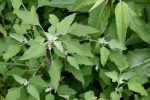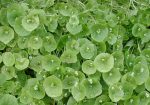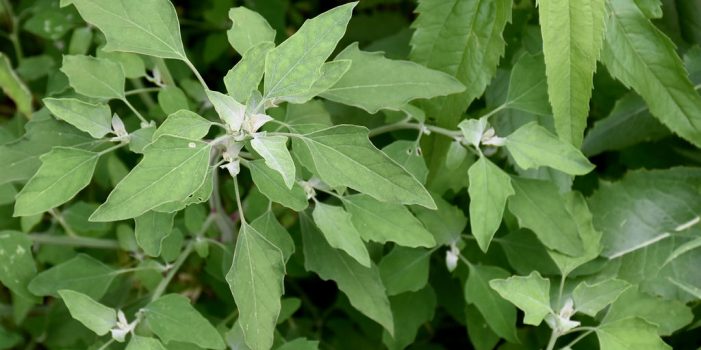We are taking a look at common weeds that can be used as food and medicine. If things go very wrong, such as in an EOTWAWKI or SHTF scenario, you may find yourself without access to doctors and hospitals and may have to take care of yourself and your family. You may want to print this and save it for such a time, when things are stressful and you may not remember the information here.
Warning: Never eat a wild plant unless you are 100 percent positive of its identification. Get yourself a good field guide, like Edible Wild Plants – A North American Field Guide.
Part 1, covered chickweed, cleavers, and dandelion. Now, let’s move on forward through the alphabet of most common weeds for food and medicine.
Lamb’s Quarters
While my husband and I lived in Oregon, we had a wonderful neighbor, Don, who took care of our home while we were away. On one of those rare but incredibly hot days, Don came over and watered our tomato and pepper plants in the green house. While he was waiting, he decided to pull all those pesky weeds that were growing so healthily. I nearly had a heart attack when I came home and all my lovely lamb’s quarters were pulled and laying in a pile. Fortunately, they were not too wilted, so I gathered them up and brought them into the house, washed them and started cooking them. Then my husband nearly had a heart attack. I expected him to eat weeds!?!
Properties
 Believe it or not, this common garden weed– Lamb’s quarters (Chenopodium album)– is actually tastier than spinach, is far more nutritious, and grows for free all over my yard. The whole plant is edible, but the seeds should be eaten sparingly unless they are cooked. Lamb’s quarters are great raw in salads or steamed/lightly cooked the same as spinach or chard. Oh, and by the way, my husband loves them.
Believe it or not, this common garden weed– Lamb’s quarters (Chenopodium album)– is actually tastier than spinach, is far more nutritious, and grows for free all over my yard. The whole plant is edible, but the seeds should be eaten sparingly unless they are cooked. Lamb’s quarters are great raw in salads or steamed/lightly cooked the same as spinach or chard. Oh, and by the way, my husband loves them.
Lamb’s quarters contains more iron, vitamin B12, B1, C, A, and protein, plus phosphorous and calcium than even cabbage and spinach. Popeye might have been indestructible if he’d have had cans of Lamb’s Quarters instead of spinach.
Medicinal Uses
A poultice from the simmered leaves is used to alleviate achy or swollen joints, rheumatism, bug bites, burns, sunstroke, urinary problems, and skin problems. The water left from simmering the leaves may be swished around in the mouth to relieve toothaches! It also has anti-parasitic, anti-inflammatory, contraceptive, and has a mild laxative effect.
Like spinach, lamb’s quarters (and especially the seeds) contain oxalic acid, which can prevent the absorption of iron and calcium, but the oxalic acid breaks down when cooked. Do not harvest from roadsides, industrial areas, as plants growing in these areas could have high amounts of nitrates.
Poisonous Look Alikes
Poisonous look alikes include species of Chenopodium, which have a bad odor and taste and can be somewhat toxic. Some say the crushed leaves smell like turpentine.
Lobelia
 Lobelia (Lobelia inflata) is preferred as medicine from the inflata (L. inflata) species; however, other species of lobelia have some of the medicinal qualities. These include great blue lobelia (L. siphilitica), pale-spike lobelia (L. spicata), Kalm’s lobelia (L. kalmia), and cardinal flower (L. cardinalis). Lobelia was a highly prized medicinal plant and used extensively by Native Americans. It was considered a panacea, being used for just about everything that ailed them.
Lobelia (Lobelia inflata) is preferred as medicine from the inflata (L. inflata) species; however, other species of lobelia have some of the medicinal qualities. These include great blue lobelia (L. siphilitica), pale-spike lobelia (L. spicata), Kalm’s lobelia (L. kalmia), and cardinal flower (L. cardinalis). Lobelia was a highly prized medicinal plant and used extensively by Native Americans. It was considered a panacea, being used for just about everything that ailed them.
Properties
Lobelia is native to Eastern North America south to Alabama and west to Kansas, from southeastern Canada (Nova Scotia to southeast Ontario), but it can be grown from seed in USDA hardiness zones 3-9.
Medicinal Uses
The seeds contain a much higher percentage of lobeline than the rest of the plant. The whole plant is used as an analgesic, cathartic, induces vomiting at higher doses, is an expectorant, induces perspiration, anti-asthmatic, antispasmodic, narcotic, and sedative. It is also used to treat convulsive and inflammatory disorders such as epilepsy, hysterical convulsions, traumatic injuries, tetanus, sores and abscesses, colds and fevers, diphtheria and tonsillitis.
Lobelia stimulates the respiratory center of the brain, producing stronger and deeper breathing, making it very useful in treating many respiratory complaints, such as asthma, chronic bronchitis, whooping cough, spasmodic croup, and pneumonia. It is also an expectorant, helping to clear both lungs and nasal passages. It also relaxes the respiratory and neuro-muscular system and acts as a nervine and antispasmodic.
When chewed it tastes similar to tobacco and produces effects like those of nicotine. Lobelia tincture in small frequent doses (5 drops) can be used to help someone overcome the very unpleasant side effects and calm the cravings of withdrawal even cold turkey withdrawal. It is used in some anti-smoking products.
A poultice of the root has been applied in treating pleurisy, rheumatism, tennis elbow, whiplash injuries, boils, ulcers and hard to heal sores. Also used for scorpion and snake bites.
“…One of the Greatest Herbs Even Given to the World…”
Lobelia has so many beneficial uses, it is the only herb that has its own chapter in Dr. Christopher’s School of Natural Healing who states “Lobelia is one of the greatest herbs ever given to the world. If the herb is used skillfully, we concur with Dr. Thompson that “there is no vegetable which the earth produces more harmless in its effect on the human system and none more powerful in removing disease and promoting health than lobelia’.”
Recipes and Doses
A recipe for lobelia infusion follows: Pour 1 cup of boiling water into l/4 to l/2 teaspoonful of the dried herb, and let steep for l0 to l5 minutes. Drink three times a day.
Lobelia tincture is made with apple cider vinegar instead of alcohol. (Alcohol does not extract the medicinal qualities of lobelia.) Take l/2 ml or 15-20 drops of the tincture.
Caution is advised, as an overdose of lobelia may cause dizziness, nausea, hypotension, vomiting, stupor, tremors, paralysis, convulsions, coma, and death. Lobelia is a low dose botanical; very small doses of the tincture– 5 to 20 drops is very effective.
Mallow
Common mallow (Malva neglecta) was the bane of my existence this past summer in my corn patch. It seemed that for every one I pulled up, 50 more grew in its place.
Properties
In spite of my struggles with it in my corn patch, mallow is extremely nutritious and is one of the richest sources of vitamin A. It has a very mild flavor and is excellent dried and powdered and used to thicken soups and smoothies.
Medicinal Uses

Common mallow is useful externally for wounds, healing sores and swellings, boils, skin rashes, insect bites, pimples, eczema, acne, and swellings. As a tea it is used to treat respiratory problems, since it has healing properties that may help the mucosa of the upper respiratory tract by coating the inflamed tissue with a protective layer, similar to its big sister marshmallow. The tea is also helpful to relieve sore throats and cough. It also has a mildly laxative effect.
I have read somewhere that giving chickens a lot of this will cause them to produce poor quality eggs, but my rabbits and goats loved them.
Poisonous Look Alikes
There are no poisonous look alikes to common mallow.
Miner’s Lettuce
Miner’s Lettuce (Claytonia perfoliata) was, without a doubt, my favorite as a child. I picked and crunched on this stuff by the handfuls.
Properties
 It is sweet and crunchy, absolutely delicious! Miner’s lettuce is so high in vitamins that it will cure scurvy. Only 100 grams (about the size of a decent salad) contains 1/3 of the daily requirement of Vitamin C, 22% of Vitamin A, and 10% of iron. Add stinging nettles, and you have everything you need to revive from a winter’s worth of heavy meats, dried grains, and roots. It is one of the first greens available, along with chickweed and dandelion after a long winter.
It is sweet and crunchy, absolutely delicious! Miner’s lettuce is so high in vitamins that it will cure scurvy. Only 100 grams (about the size of a decent salad) contains 1/3 of the daily requirement of Vitamin C, 22% of Vitamin A, and 10% of iron. Add stinging nettles, and you have everything you need to revive from a winter’s worth of heavy meats, dried grains, and roots. It is one of the first greens available, along with chickweed and dandelion after a long winter.
Medicinal Uses
The leaves are gently laxative and are an effective diuretic. A poultice of the mashed plants has been applied to rheumatic joints.
I suppose you could cook miner’s lettuce, but I cannot imagine why you would. It is delicious just crunched on raw or made into a salad. All parts are edible.
Poisonous Look Alikes
Miner’s lettuce has no poisonous look alikes.
Tomorrow, we will continue on in our pursuit to review the most common weeds available for use as food and medicine.
See Also:
- 1- Common “Weeds” as Food and Medicine- Part 1, by M.C.
- 3- Common “Weeds” as Food and Medicine- Part 3, by M.C. (Active on 12/6/18)
- 4- Common “Weeds” as Food and Medicine- Part 4, by M.C. (Active on 12/6/18)
SurvivalBlog Writing Contest
This has been another entry for Round 80 of the SurvivalBlog non-fiction writing contest. The nearly $11,000 worth of prizes for this round include:
First Prize:
- A $3000 gift certificate towards a Sol-Ark Solar Generator from Veteran owned Portable Solar LLC. The only EMP Hardened Solar Generator System available to the public.
- A Gunsite Academy Three Day Course Certificate. This can be used for any one, two, or three day course (a $1,095 value),
- A course certificate from onPoint Tactical for the prize winner’s choice of three-day civilian courses, excluding those restricted for military or government teams. Three day onPoint courses normally cost $795,
- DRD Tactical is providing a 5.56 NATO QD Billet upper. These have hammer forged, chrome-lined barrels and a hard case, to go with your own AR lower. It will allow any standard AR-type rifle to have a quick change barrel. This can be assembled in less than one minute without the use of any tools. It also provides a compact carry capability in a hard case or in 3-day pack (an $1,100 value),
- Two cases of Mountain House freeze-dried assorted entrees in #10 cans, courtesy of Ready Made Resources (a $350 value),
- A $250 gift certificate good for any product from Sunflower Ammo,
- American Gunsmithing Institute (AGI) is providing a $300 certificate good towards any of their DVD training courses.
Second Prize:
- A Model 175 Series Solar Generator provided by Quantum Harvest LLC (a $439 value),
- A Glock form factor SIRT laser training pistol and a SIRT AR-15/M4 Laser Training Bolt, courtesy of Next Level Training, which have a combined retail value of $589,
- A gift certificate for any two or three-day class from Max Velocity Tactical (a $600 value),
- A Three-Day Deluxe Emergency Kit from Emergency Essentials (a $190 value),
- Two 1,000-foot spools of full mil-spec U.S.-made 750 paracord (in-stock colors only) from www.TOUGHGRID.com (a $240 value).
- An assortment of products along with a one hour consultation on health and wellness from Pruitt’s Tree Resin (a $265 value).
Third Prize:
- A Royal Berkey water filter, courtesy of Directive 21 (a $275 value),
- A large handmade clothes drying rack, a washboard, and a Homesteading for Beginners DVD, all courtesy of The Homestead Store, with a combined value of $206,
- Expanded sets of both washable feminine pads and liners, donated by Naturally Cozy (a $185 retail value),
- Two Super Survival Pack seed collections, a $150 value, courtesy of Seed for Security, LLC,
- Mayflower Trading is donating a $200 gift certificate for homesteading appliances.
Round 80 ends on January 31st, so get busy writing and e-mail us your entry. Remember that there is a 1,500-word minimum, and that articles on practical “how to” skills for survival have an advantage in the judging.











I can see now I’m going to have to enlarge my garden in the spring! These are wonderful suggestions.
I’m enjoying this article! The plants listed, so far, all grow in and around my yard and garden in the spring and fall when the weather is cooler. They do not like the heat in the mid-south. I harvest them for my rabbits, but next year I’ll be sure to dry some for medicinal purposes.
Friend M.C.–Might you have picture of lobelia and mallow before they bloom? Seems to me the leaves have more potency in the time before flowering.
You are doing a fine job, IMO. I greatly enjoy introducing people to edible weeds in our local area.
Carry on.
The mallow looks the same before blooming and during – except with the addition of flowers. For lobelia, I’d suggest on on-line search or a good field guide – just to be sure you have the right plant.